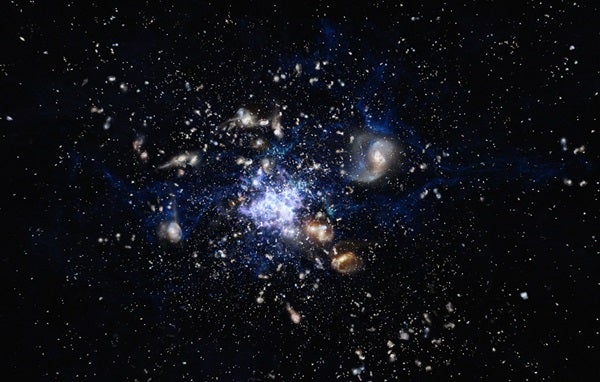Lyman-alpha emission is a specific wavelength of light given off by neutral hydrogen as it cools after heating that allows astronomers to trace the location of this gas. Lyman-alpha blobs are large structures of gas emitting at this wavelength that are associated with young galaxies in the early universe. The emission seen from these blobs is typically assumed to arise from the high levels of radiation given off by quasars, star formation, or even supernovae in the galaxies they surround. Astronomers have recently discovered one of the largest Lyman-alpha structures found to date, but the source of this huge object’s glow is not exactly obvious.
MAMMOTH-1 is an enormous Lyman-alpha nebula, or ELAN for short. It’s a huge structure of hydrogen gas that sits at a distance of 10 billion light-years from Earth in the center of a dense concentration of galaxies. Its discovery was announced in a paper accepted for publication in the Astrophysical Journal and also available online, authored by Zheng Cai, a Hubble Postdoctoral Fellow at UC Santa Cruz, and several associates. The structure’s name is derived from the survey that found it: Mapping the Most Massive Overdensities Through Hydrogen, or MAMMOTH.
MAMMOTH-1 is not the first ELAN to be discovered. Coauthor J. Xavier Prochaska, a professor of astronomy and astrophysics at UC Santa Cruz, found the first ELAN in 2014, known as the Slug Nebula.
MAMMOTH-1’s location in and of itself isn’t unusual, as Lyman-alpha blobs such as ELANs have been discovered around the highest densities of matter throughout the universe. However, what is unusual is that previously discovered ELANs are all associated with visible quasars, which provide an obvious mechanism responsible for the Lyman-alpha emission they produce. MAMMOTH-1 is not.
Quasars are intensely bright sources of radiation that arise from the disks of matter swirling around supermassive black holes. When a quasar’s high-energy photons hit hydrogen gas (such as that in MAMMOTH-1), they knock electrons away in a process called photoionization. The electrons are later recaptured by the hydrogen atoms, which gives off Lyman-alpha light. Alternatively, a quasar can produce outflows that heat the hydrogen gas of a Lyman-alpha blob via shocks, which also produces Lyman-alpha emission.
MAMMOTH-1 is “extremely bright, and it’s probably larger than the Slug Nebula, but there’s nothing else visible except the faint smudge of a galaxy. So it’s a terrifically energetic phenomenon without an obvious power source,” said Prochaska in a press release.
MAMMOTH-1’s home is a proto-cluster that consists of a huge number of galaxies spread out in a relatively large area just 3 billion years after the Big Bang. Given time to evolve, the protocluster should come to resemble the densely-packed galaxy clusters we see in our local universe today. Proto-clusters represent an early step in cosmic evolution, and it’s thought that gas flows along a “cosmic web” of invisible dark matter to form stars and galaxies. And, in fact, MAMMOTH-1 itself has a filamentary structure, which the team believes traces out the cosmic web that’s growing the protocluster over time. Thus, MAMMOTH-1 acts as an illuminated portion of the cosmic web, showing astronomers where gas is flowing into this high-density area of the universe. According to Cai, “From the distribution of galaxies we can infer where the filaments of the cosmic web are, and the nebula is perfectly aligned with that structure.”
As for the mystery of MAMMOTH-1’s power source, Cai and his coauthors speculate that it’s likely an active supermassive black hole that’s simply obscured by dust and gas, and thus not readily visible in optical light. This idea is supported by evidence they’ve gathered during their observations, including the dynamics of MAMMOTH-1’s gas and the emission visible from elements other than hydrogen in the vicinity.










